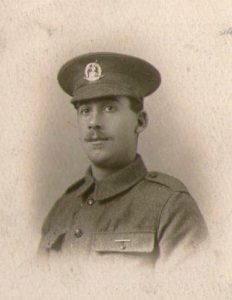
Thank you to Westcott Local History Group for allowing Dorking Museum to publish their First World War research.
George Henry Tarrant was born in 1893, the son of Thomas and Sarah Tarrant who lived at Taw’s Farm, Balchin’s Lane, Westcott. He was a very able boy at school and gained a scholarship. After leaving school he worked as a clerk in Westcott Post Office.
Shortly after the war started George attested for service in the Norfolk Regiment – in Norwich on 8th September 1914. However, it appears that his documents were lost. He formally re-enlisted on 29th March 1915 at Shoreham, Sussex and joined 9th Bn The Norfolk Regiment which was training there as part of the 24th Division. Although the initial training was hampered by a lack of equipment, experienced officers and NCOs, the Division completed its preparations the following summer and landed at Boulogne on 30th August 1915. George clearly had good leadership qualities, as he progressed through the ranks and was promoted to Sergeant in September 1916.
After a short stop at Etaples, near Boulogne, the Division marched some 50 miles to be part of the reserve for the assault at Loos; here they went into action for the first time and suffered heavy losses. On 15th October 1915 the 9th Norfolks were transferred to the 6th Division which was subsequently involved in the actions at Flers-Courcelette, Morval and Le Transloy during the final stages of the Battle of the Somme. It was during this period that Sgt Tarrant was hospitalised for almost 3 months with scarlet fever, returning to duty in October 1916.
Following the Battle of the Somme the German Army carried out a strategic withdrawal to a new defensive position known as the ‘Hindenburg Line’. The Allies resolved to breach this line with a new offensive at Arras and Vimy Ridge which began on 9th April 1917. The battle was fought in bitterly cold weather and the Allies gained ground, notably by the Canadians who captured Vimy Ridge, but at a huge cost and the offensive was halted on April 16th.
At the time of these operations the 6th Division was defending a front of 11,000 yards north of Loos when, on 13th April it was learnt that the German force opposing them were contemplating a withdrawal after the Canadians had taken Vimy. Units of the Division followed in pursuit and bitter fighting broke out along the front. The Germans were anxious to hold on to a feature known as Hill 70 which threatened the Canadians on Vimy Ridge, and they concentrated exceptionally heavy fire on the Division’s units in that part of the front. One Brigade Commander described how ‘battalions relieved from the fighting front one night were put straight in to the line elsewhere on the following night and 24 hours later had to deliver an attack. The enemy concerned about the fate of Hill 70 concentrated formidable artillery fire on the front involved and ….the barrages were of exceptional severity.’ The Division was to remain on this front for a further three months until it was relieved on 25th July. Hill 70 was finally captured by Canadian forces in August 1917.
In April 1917 Sgt Tarrant received a commendation from his Divisional Commander which read as follows:
‘Your Commanding Officer and Brigade Commander have informed me that you distinguished yourself by your consistent good work and devotion to duty and that your coolness and cheerfulness has proved an excellent example to the remainder of the battalion.
I have read their report with much pleasure.’
C.Ross Major-General Commanding 6th Division.
Sgt. George Tarrant was killed in action on 28th April 1917, one of 12 men of the battalion who died that day. On 11th May 1917 it was announced in the London Gazette that Sgt. Tarrant had been posthumously awarded the Military Medal, a decoration which is awarded ‘in recognition of an act or acts of exemplary gallantry during active operations against the enemy.’ The reverse of the medal is simply inscribed ‘For Bravery in the Field’. We do not know the circumstances of George Tarrant’s death or the reasons for the award as no citation was published – this was standard practice during the war when acts of such gallantry occurred so frequently. The award may have followed the Divisional Commander’s commendation.
George Tarrant is buried in St Patrick’s Cemetery, near Loos. He is also remembered on the village war memorial at Shere.
| Born | Westcott, Surrey | |
| Lived | Shoreham, West Sussex | |
| Son of | Thomas William & Sarah Tarrant, Taw’s Farm, Balchin’s Lane, Westcott | |
| Regiment | 9th Battalion. Norfolk Regiment | |
| Number | 19155 | |
| Date of Death | 28th April 1917 | |
| Place of Death | Loos, France | |
| Cause of Death | Killed in action | |
| Age | 24 | |
| Cemetery | St. Patrick’s Cemetery, Loos, France |

